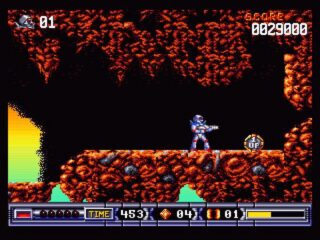Contra III: The Alien Wars marked the debut of the iconic Konami run-and-gun series on the Super Nintendo in 1992. Developed and published by Konami, the game was created by a team that included veterans from earlier Contra titles. Known in Japan as Contra Spirits, the game aimed to modernize the series using the SNES’s superior capabilities.
Compared to its NES predecessors (Contra and Super C), Contra III offered significant technical and gameplay improvements. The SNES allowed for detailed sprites, more dynamic animations, and enhanced sound.
The gameplay stayed faithful to the Contra formula: fast-paced action, tight controls, and high difficulty. However, Contra III added new features like the ability to carry and switch between two weapons, the option to climb walls and hang from ledges, and screen-clearing smart bombs. The variety in level design stood out, alternating between side-scrolling chaos and overhead stages that changed the pace. Bosses were especially memorable, with huge, screen-filling enemies that often required complex patterns and reflexes to defeat.
The story, though minimal, placed players once again in a war against alien invaders led by the villain Red Falcon. The setting shifted to a ruined futuristic Earth, portrayed with rich backgrounds and a gritty atmosphere. The game's soundtrack was intense and fitting, with compositions that pushed the SNES hardware and matched the frantic action on screen.
Compared to earlier Contra titles, Contra III was more cinematic and varied in its gameplay. The difficulty remained high, but the ability to use continues and pick up different weapons added a layer of strategy. The two-player cooperative mode, a series staple, was intact and essential for those wanting to take on the alien menace with a friend.
Two of the six stages in Contra III: The Alien Wars abandon the traditional side-scrolling view in favor of a top-down perspective. These levels were designed to showcase the SNES’s Mode 7 capabilities, allowing players to rotate the battlefield using the L and R shoulder buttons. The change in viewpoint forces a different play style: instead of jumping and climbing, the focus shifts to free movement in eight directions and managing enemies approaching from all sides. Objectives in these stages typically involve locating and destroying several targets across the map, adding a tactical layer to the usual run-and-gun action. While not as fast-paced as the side-scrolling levels, they provide variety and break the rhythm in a way that was innovative for the time.
Contra III is widely considered one of the best entries in the series and a hallmark of 16-bit action games. Its success helped define what run-and-gun games could be on home consoles, blending arcade action with console polish. The game was critically acclaimed and remains a fan favorite, often listed among the best SNES titles of all time.














